We’ve all craved that perfect balance between minimalist elegance and cozy warmth in our living spaces. Japandi design masterfully combines Japanese simplicity with Scandinavian hygge to create interiors that feel both serene and inviting. This emerging style has captured hearts worldwide because it transforms ordinary rooms into peaceful sanctuaries.
The beauty of Japandi living rooms lies in their effortless sophistication. Clean lines meet natural textures while neutral palettes create visual harmony throughout the space. We’re talking about rooms that breathe calmness into your daily routine without sacrificing functionality or comfort.
Ready to discover how this timeless aesthetic can revolutionize your living room? We’ll guide you through the essential elements that make Japandi interiors so captivating – from selecting the right color schemes to choosing furniture that embodies this philosophy of intentional living.
Embrace Natural Materials for Authentic Japandi Style
Natural materials form the foundation of authentic Japandi living rooms, creating spaces that feel both grounded and serene. These organic elements bridge the gap between Japanese minimalism and Scandinavian warmth perfectly.
Choose Solid Wood Furniture Pieces
Wood becomes the cornerstone of Japandi design when we select pieces with clean lines and natural grain patterns. Oak coffee tables with simple rectangular forms anchor our living spaces without overwhelming the room’s peaceful atmosphere. Walnut side tables bring rich tones that complement neutral wall colors beautifully.
Teak dining chairs offer durability while maintaining the sleek aesthetic that defines Japandi interiors. We recommend choosing furniture with visible wood grain rather than painted finishes to showcase the material’s natural beauty. Pine bookshelves with open designs provide storage while keeping sight lines clear and uncluttered.
Incorporate Bamboo and Rattan Accents
Bamboo elements introduce texture and warmth without disrupting the minimalist foundation of our Japandi spaces. Pendant lights crafted from woven bamboo create soft lighting that enhances the room’s tranquil mood. Floor lamps with bamboo shades filter light gently while adding vertical interest to corner spaces.
Rattan baskets serve dual purposes as both storage answers and decorative elements that reinforce the natural theme. We love using rattan ottomans as flexible seating options that can move throughout the room as needed. Window treatments made from bamboo blinds provide privacy while maintaining the organic aesthetic.
Add Stone and Ceramic Elements
Stone accents ground our Japandi living rooms with their substantial presence and natural variations. Granite or slate side tables bring cool tones that balance the warmth of wood furniture effectively. River rock arrangements in shallow ceramic bowls create focal points that celebrate nature’s imperfect beauty.
Ceramic vases in neutral tones like cream or soft gray display single stems or dried branches perfectly. We choose handmade pottery pieces that show slight irregularities and artisan touches rather than mass-produced items. Stone planters housing small succulents or air plants add life to our spaces while maintaining the serene atmosphere.
Create a Neutral Color Palette Foundation

Building on natural materials, we’ll establish a cohesive color foundation that captures Japandi’s serene essence. This carefully curated palette forms the backbone of our tranquil living space.
Start with Warm Whites and Soft Beiges
Warm whites serve as our primary wall color to maintain an airy and spacious feel throughout the room. Off white shades create a gentle backdrop that enhances natural light while avoiding the stark coldness of pure white.
Soft beiges add essential warmth and coziness to our Japandi living space. These gentle neutral tones work beautifully on accent walls or through textiles like throw pillows and area rugs.
Consider cream and ivory variations to introduce subtle depth without overwhelming the minimalist aesthetic. These foundational colors allow our natural wood furniture and stone accents to become the room’s focal points.
Introduce Muted Earth Tones
Muted earth tones bring essential depth and balance to our neutral foundation. Earthy browns and soft grays reflect the natural industry while maintaining the calming atmosphere central to Japandi design.
Incorporate these colors through larger furniture pieces like upholstered sofas in mushroom gray or taupe. Natural clay and sand tones work exceptionally well for ceramic accessories and handmade pottery displays.
Sage green and dusty olive can serve as subtle accent colors that connect our interior to nature’s palette. These earth inspired hues enhance the organic feel without disrupting the room’s peaceful harmony.
Balance Cool and Warm Undertones
Cool undertones from muted grays balance beautifully with warm undertones from our wooden furniture pieces. This temperature contrast creates visual interest while maintaining the harmonious atmosphere essential to Japandi style.
Blend cool stone gray accessories with warm oak coffee tables to achieve this perfect equilibrium. The interplay between these undertones adds sophistication without sacrificing the style’s inherent simplicity.
Warm beige textiles can soften cool gray walls while maintaining our monochromatic scheme. This thoughtful balance ensures our living room feels both elegant and inviting rather than sterile or overwhelming.
Prioritize Clean Lines and Minimalist Furniture
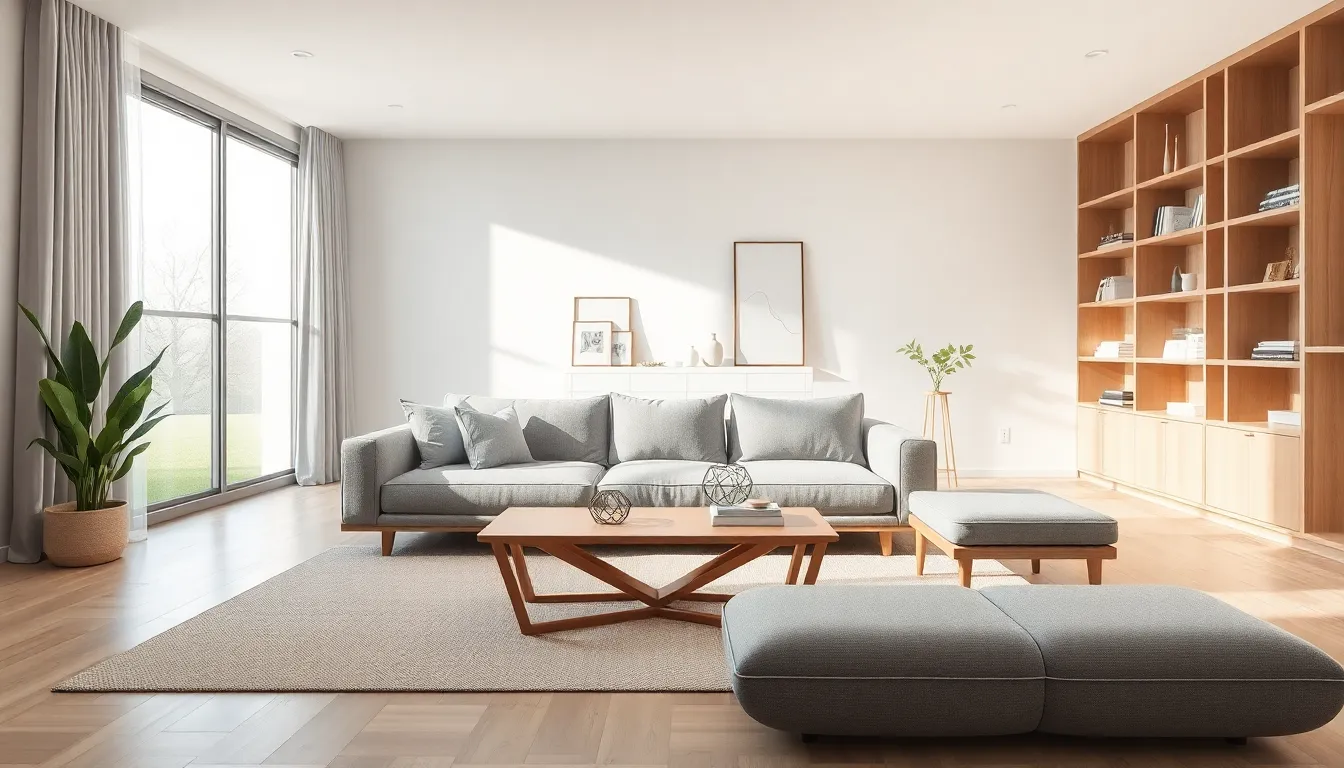
Furniture selection forms the backbone of any successful Japandi living room design. We need to focus on pieces that embody simplicity while maintaining exceptional functionality.
Select Low-Profile Seating Options
Low sofas and chairs create the foundation of authentic Japandi design by bringing us closer to the ground. This seating approach establishes a relaxed, informal environment that promotes tranquility and meditation. We recommend choosing sofas with seat heights between 15-17 inches, which align with traditional Japanese floor seating customs while maintaining Scandinavian comfort standards.
Platform sofas with wooden frames exemplify this principle perfectly, offering clean silhouettes without sacrificing support. Floor cushions and meditation pillows can supplement your main seating, creating flexible arrangements for gatherings. These low profile choices enhance the room’s spacious feel by maintaining unobstructed sight lines across the space.
Choose Furniture with Simple Geometric Shapes
Geometric simplicity drives the visual harmony essential to Japandi aesthetics. We should select pieces featuring rectangles, squares, and gentle curves that create order without complexity. Square coffee tables with subtly rounded edges demonstrate this principle beautifully, offering functionality while maintaining visual balance.
Rectangular dining tables in light oak or ash wood provide gathering spaces that feel both structured and organic. Circular side tables can soften sharp angles when used sparingly, but we must avoid ornate detailing or decorative flourishes. Open shelving units with square frames create storage opportunities while preserving the minimalist theme through their straightforward construction.
Invest in Multi-Functional Storage Answers
Storage furniture must work double duty in Japandi living rooms to maintain our clutter free environment. Ottoman storage benches provide seating while concealing blankets, books, and remote controls within their hidden compartments. These pieces eliminate visual chaos by keeping everyday items completely out of sight.
Modular shelving systems offer flexibility for displaying carefully curated objects while providing concealed storage behind closed cabinet doors. We can incorporate built in storage benches along windows or walls, creating reading nooks that serve multiple purposes. Console tables with drawers combine display surfaces with hidden storage, supporting our minimalist goals through thoughtful design integration.
Incorporate Japanese-Inspired Design Elements
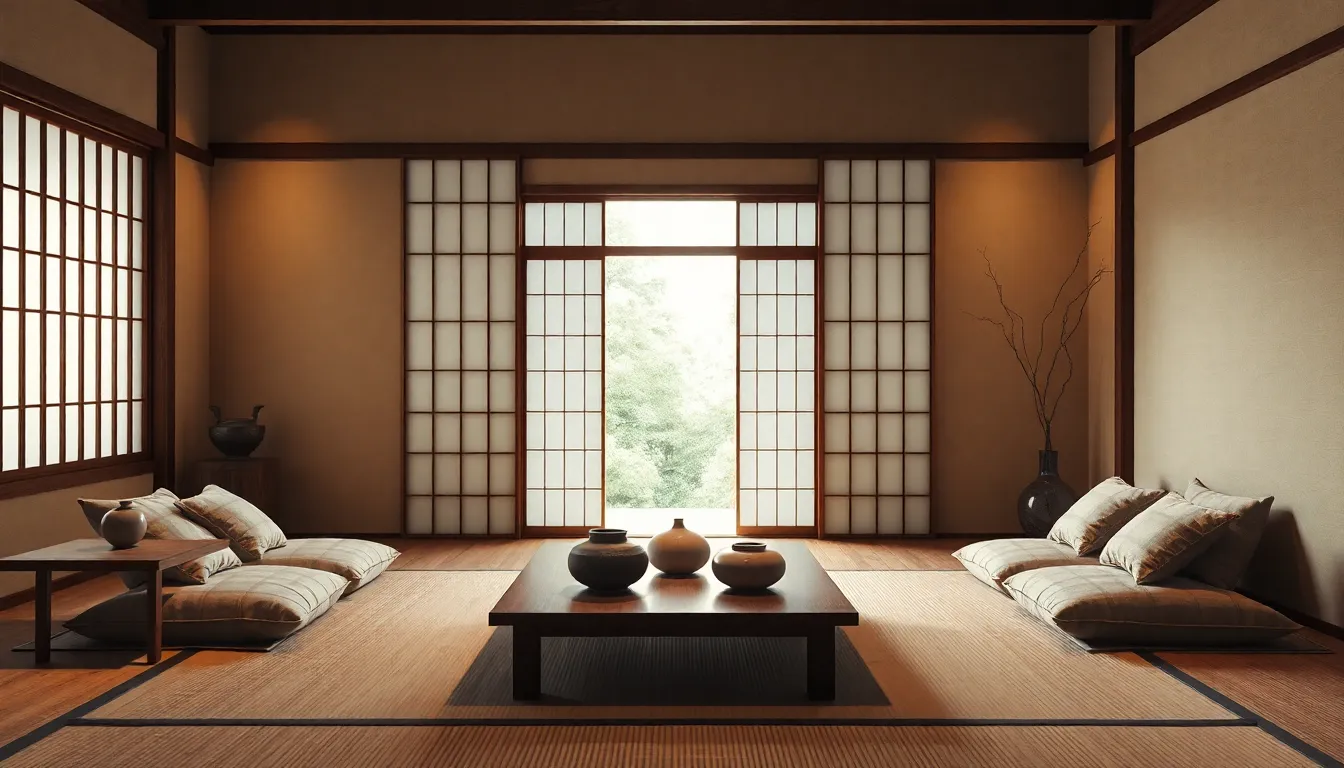
Taking our Japandi living room design further, we can integrate authentic Japanese elements that deepen the cultural connection while maintaining the style’s signature minimalism.
Add Shoji Screen Room Dividers
Shoji screens bring traditional Japanese elegance into our Japandi living spaces while serving practical dividing functions. These translucent paper panels create subtle separation between areas without blocking natural light flow throughout the room. We can position them strategically to define seating areas or create intimate reading nooks within larger open floor plans.
Installing floor-to-ceiling shoji screens adds vertical interest and authentic cultural depth to our living room design. The wooden lattice framework complements our existing natural materials while the soft paper panels diffuse harsh lighting into gentle ambient illumination. Modern adaptations feature sliding mechanisms that allow us to adjust privacy levels throughout the day.
Display Minimalist Pottery and Ceramics
Minimalist pottery showcases the Japanese principle of thoughtful decoration without overwhelming our carefully curated spaces. We can select handcrafted ceramic pieces with simple forms and earthy glazes that echo our neutral color palette. Display these items on floating shelves or low wooden tables where their organic shapes create visual focal points.
Ceramic vessels serve both decorative and functional purposes in our Japandi living rooms. Large floor vases hold dried grasses or single branch arrangements while smaller bowls contain natural elements like smooth river stones. The imperfect beauty of handmade ceramics adds authentic character that machine-made pieces simply cannot replicate.
Include Traditional Floor Cushions and Tatami Mats
Floor cushions transform our living rooms into flexible spaces that honor traditional Japanese seating customs. These low profile seating options encourage relaxation and create intimate conversation areas around coffee tables. We can choose cushions covered in natural linen or cotton fabrics that coordinate with our established neutral tones.
Tatami mats define exact zones within our living spaces while adding textural warmth underfoot. These woven rush mats bring cultural authenticity and natural fragrance that enhances the serene atmosphere we’re creating. Layering them strategically creates cozy seating areas that invite guests to slow down and enjoy mindful moments together.
Blend Scandinavian Hygge Comfort Features

Japandi design perfectly merges the functionality of Scandinavian aesthetics with Japanese minimalism to create spaces that embrace both warmth and simplicity. This harmonious blend allows us to incorporate Hygge elements that emphasize comfort while maintaining the clean, uncluttered essence of Japanese design principles.
Layer Soft Textiles and Cozy Throws
Soft textiles form the foundation of comfort in our Japandi living rooms, bringing essential warmth without compromising the minimalist aesthetic. We recommend selecting throws and cushions in neutral shades like beige, gray, and white to maintain visual harmony while adding tactile comfort. Natural linen throws work exceptionally well draped over low-profile sofas, creating inviting textures that beckon relaxation. Cotton blankets in muted earth tones provide another layer of coziness while staying true to the color palette we’ve established.
Cashmere throws offer luxurious softness that elevates the space without overwhelming it with bold patterns or colors. We suggest folding these textiles neatly rather than arranging them haphazardly, maintaining the organized simplicity that Japandi design demands. Organic cotton cushions in varying sizes create visual interest while providing comfortable support for extended lounging sessions.
Create Reading Nooks with Warm Lighting
Reading nooks become sanctuaries of tranquility when we incorporate warm lighting that mimics the gentle glow of candlelight. Table lamps with soft fabric shades positioned beside low seating areas create intimate spaces perfect for quiet contemplation and literary escape. Floor lamps featuring bamboo or wood bases align with our natural material choices while casting gentle pools of light that don’t disturb the room’s peaceful atmosphere.
We recommend using warm LED bulbs with color temperatures between 2700K and 3000K to achieve that coveted Hygge ambiance. Paper lantern pendant lights suspended at varying heights add vertical interest while providing soft, diffused illumination that flatters both people and spaces. Salt lamps carved from natural Himalayan rock offer ambient lighting that complements the earthen tones in our Japandi palette.
Candles arranged on wooden trays create flickering focal points that engage multiple senses, bringing the meditative quality that both Scandinavian and Japanese cultures cherish.
Add Sheepskin Rugs for Texture
Sheepskin rugs introduce essential tactile elements that ground our minimalist spaces with natural warmth and comfort. These organic textures provide soft contrast against clean hardwood floors while maintaining the neutral color story we’ve woven throughout the room. We position sheepskin rugs strategically near seating areas where bare feet naturally seek comfort and warmth.
Natural white and cream sheepskins blend seamlessly with our established palette, while gray options add subtle depth without disrupting visual harmony. Single large sheepskins work beautifully as accent pieces, while smaller ones can be layered to create cozy conversation areas. These rugs serve dual purposes by defining spaces within our open floor plans while adding the luxurious comfort that Hygge philosophy celebrates.
Genuine sheepskin offers superior softness and temperature regulation compared to synthetic alternatives, making them practical investments for year-round comfort. We arrange them thoughtfully to create natural pathways that guide movement through the space while providing moments of sensory delight.
Maximize Natural Light Throughout the Space
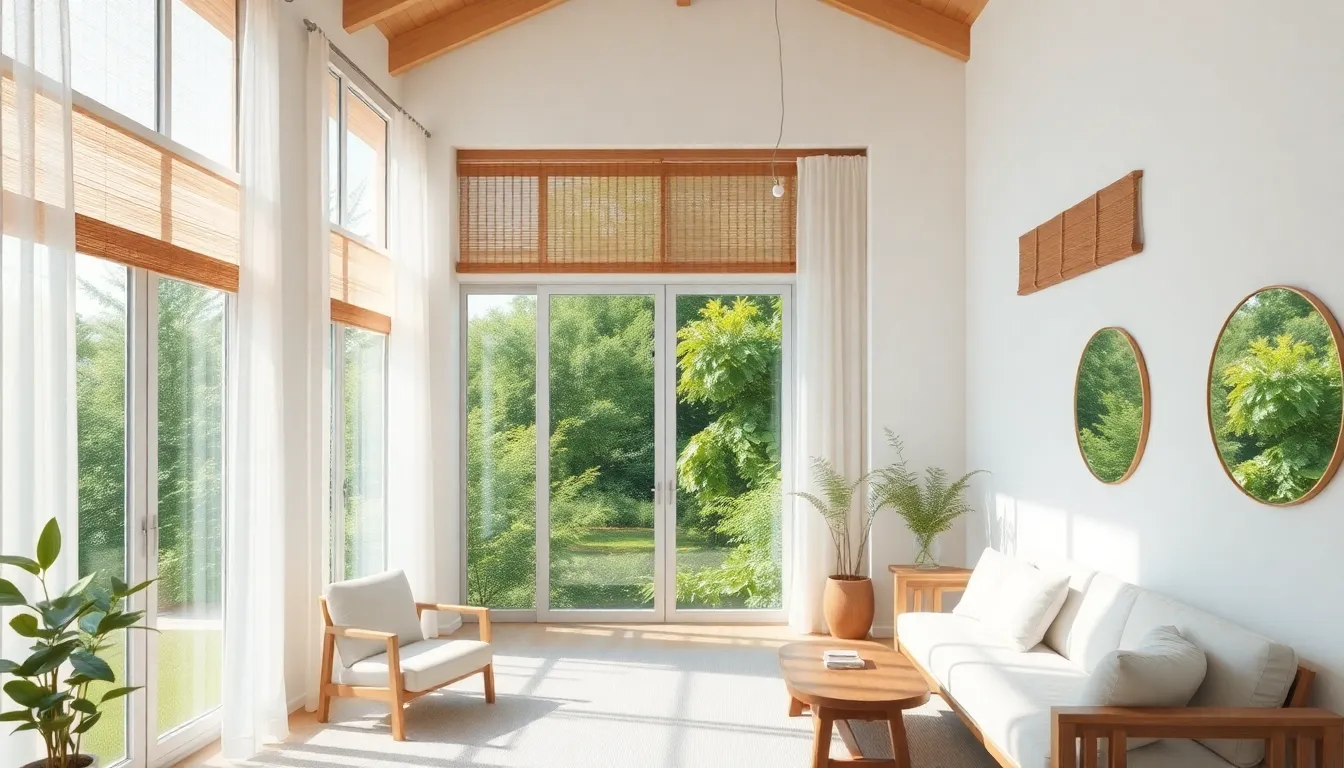
Light transforms the serene atmosphere we’ve created with our natural materials and neutral color palette. Abundant natural light amplifies the peaceful essence of Japandi design by highlighting the organic textures and warm tones throughout our living room.
Remove Heavy Window Treatments
Heavy drapes and thick curtains block the essential brightness that makes Japandi interiors feel open and airy. We recommend eliminating these bulky window coverings that create visual weight and diminish the minimalist aesthetic we’re cultivating.
Dark fabrics and ornate valances contradict the clean lines and simplicity that define authentic Japandi style. Removing these treatments immediately opens up the space and allows our carefully chosen furniture pieces to become the focal points.
Bare windows maintain the uncluttered environment that’s fundamental to this design philosophy. We find that exposed glass creates an uninterrupted connection between our interior sanctuary and the natural industry outside.
Use Sheer Curtains or Bamboo Blinds
Sheer linen curtains filter sunlight while preserving the privacy we need in our living spaces. These lightweight fabrics in cream or natural tones complement our neutral color story without overwhelming the room’s serene atmosphere.
Bamboo blinds add an authentic natural element that reinforces the Japanese influence in our design approach. We choose horizontal slat blinds in warm honey or light oak finishes that echo our wooden furniture pieces.
Woven grass blinds provide texture variation while maintaining the organic feel we’ve established throughout the room. These natural window treatments allow gentle light diffusion that creates soft shadows and enhances the peaceful ambiance.
Roll up blinds offer flexibility in light control while disappearing completely when raised. We position these treatments to frame our windows without adding visual bulk to the clean architectural lines.
Position Mirrors to Reflect Available Light
Strategic mirror placement doubles the natural light entering our Japandi living room spaces. We position large mirrors opposite or adjacent to windows to capture and redistribute sunlight throughout the entire room.
Round mirrors with simple wooden frames echo the geometric shapes in our minimalist furniture selection. These pieces reflect both light and our carefully curated neutral color palette back into the space.
Floor leaning mirrors in light oak or bamboo frames serve dual purposes as functional elements and light amplifiers. We place these oversized pieces where they’ll catch the most sunlight during peak daylight hours.
Multiple smaller mirrors create light pockets in darker corners without cluttering our minimalist aesthetic. We group two or three simple geometric mirrors to maximize brightness while maintaining the clean visual balance that defines Japandi style.
Introduce Greenery with Mindful Plant Selection

Thoughtful plant selection brings nature’s tranquility into our Japandi living spaces while maintaining the design’s essential minimalist principles. We’re focusing on species that enhance rather than overwhelm the serene atmosphere we’ve carefully cultivated.
Choose Low-Maintenance Indoor Plants
Succulents and air plants become our go-to choices for authentic Japandi greenery because they require minimal care and embody the minimalist aesthetic perfectly. These plants thrive with infrequent watering and naturally complement the clean lines of our furniture selections.
Ferns add elegant foliage that reflects natural harmony without demanding constant attention from busy homeowners. Peace lilies offer simple, graceful leaves that align with our neutral color palette while requiring only weekly watering.
Snake plants provide vertical interest with their architectural forms, making them ideal companions to our geometric furniture pieces. ZZ plants tolerate low light conditions exceptionally well, allowing us to place greenery throughout the space regardless of natural light availability.
Display Plants in Simple Ceramic Planters
Neutral colored planters in white, beige, or gray blend seamlessly with our established Japandi color palette of soft whites, warm beiges, muted grays, and earthy browns. We’re selecting containers that disappear into the background, letting the plants themselves become the focal point.
Clean lined ceramic vessels without ornamental details maintain the sleek, uncluttered vibe that defines our Japandi interiors. Matte finishes work better than glossy surfaces because they create a more organic, natural appearance.
Round and rectangular planters in varying heights add visual rhythm while staying true to the geometric simplicity we’ve emphasized throughout our furniture choices. Matching planter sets create cohesion when grouping multiple plants together.
Create a Small Indoor Garden Corner
Designated corner spaces become cozy nooks when we combine plants with natural elements like reclaimed wood shelving or smooth river stones. This approach creates an inviting focal point that celebrates our connection to nature.
Natural lighting becomes essential for these garden corners, so we’re positioning them near windows where plants receive ample sunlight to thrive. The bright, airy feel characteristic of Japandi design gets enhanced when greenery bathes in natural illumination.
Bamboo plant stands and wooden stools provide elevated surfaces for our plant displays while reinforcing the natural material story we’ve woven throughout the space. Grouping plants at different heights creates visual interest without cluttering the minimalist aesthetic we’ve worked to achieve.
Focus on Quality Over Quantity Approach
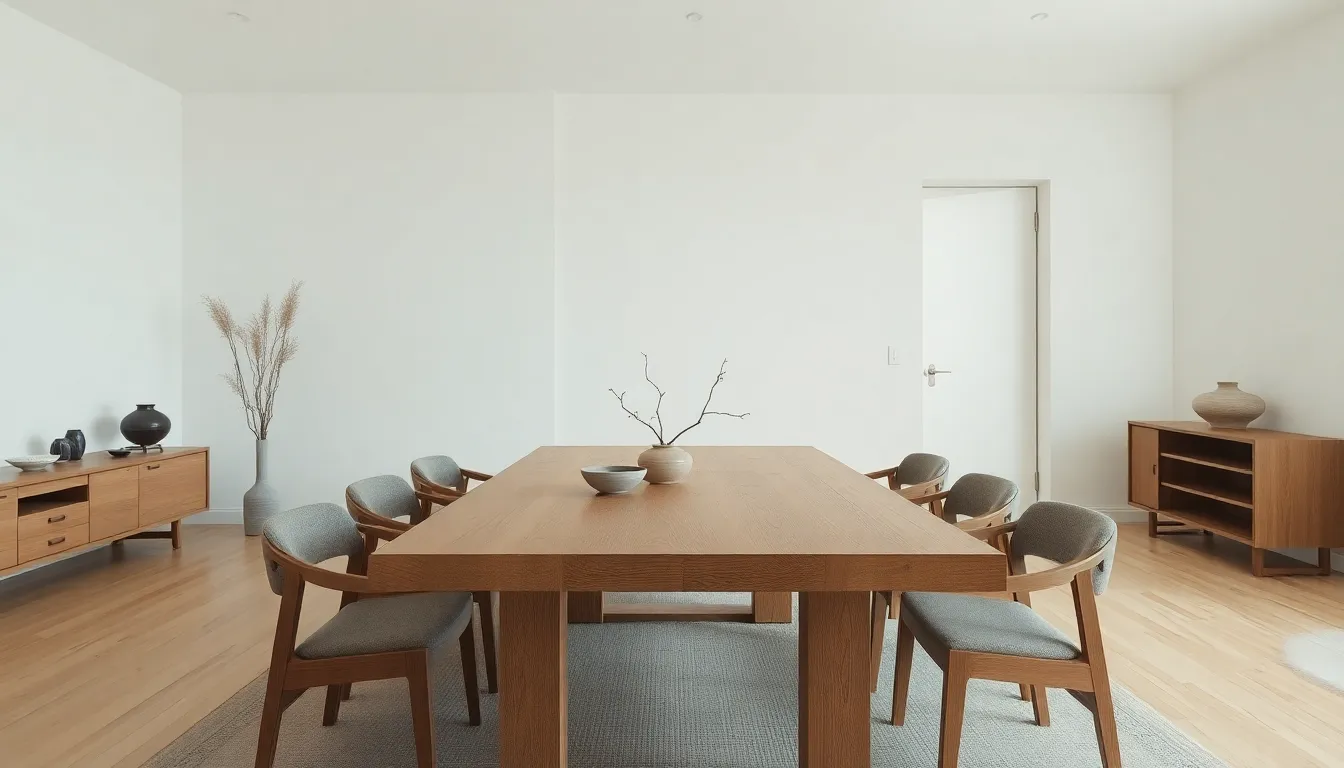
When creating our Japandi living room, we prioritize fewer high-quality pieces over many budget items. This philosophy reflects the core principle of both Japanese and Scandinavian design cultures.
Invest in Well-Made Statement Pieces
We select furniture that showcases exceptional craftsmanship and minimalist elegance. A solid oak dining table or handcrafted walnut coffee table becomes the room’s focal point while serving multiple functions.
Quality furniture pieces in Japandi style feature clean construction without visible hardware or ornate details. We choose pieces made from single materials like pure wood or natural stone rather than composite alternatives.
Investing in statement seating means selecting a well-built sofa with linen upholstery or a wooden bench with traditional joinery techniques. These pieces should last decades while maintaining their aesthetic appeal and structural integrity.
Curate Meaningful Decorative Objects
We display only items that serve a purpose or hold personal significance in our Japandi space. Each decorative element should contribute to the room’s serene atmosphere while avoiding visual clutter.
Natural elements like smooth river stones, handmade ceramic bowls, or a single branch arrangement create focal points without overwhelming the space. We limit decorative objects to three or fewer per surface to maintain the minimalist aesthetic.
Meaningful objects might include a vintage wooden sculpture, handwoven textile art, or ceramic pottery that reflects traditional craftsmanship. These pieces should align with our neutral color palette of whites, beiges, and muted earth tones.
Maintain Clutter-Free Surfaces
We keep countertops, side tables, and coffee tables free from unnecessary items to preserve the calm Japandi atmosphere. Clear surfaces allow the eye to rest and appreciate the room’s natural materials and textures.
Storage answers with hidden compartments help us maintain this uncluttered look while keeping essential items accessible. We choose furniture pieces like ottomans with interior storage or console tables with concealed drawers.
Daily maintenance involves returning items to their designated places and avoiding the accumulation of mail, magazines, or decorative accessories on visible surfaces. This practice reinforces the peaceful, organized feeling that defines authentic Japandi design.
Design Dedicated Meditation and Relaxation Zones
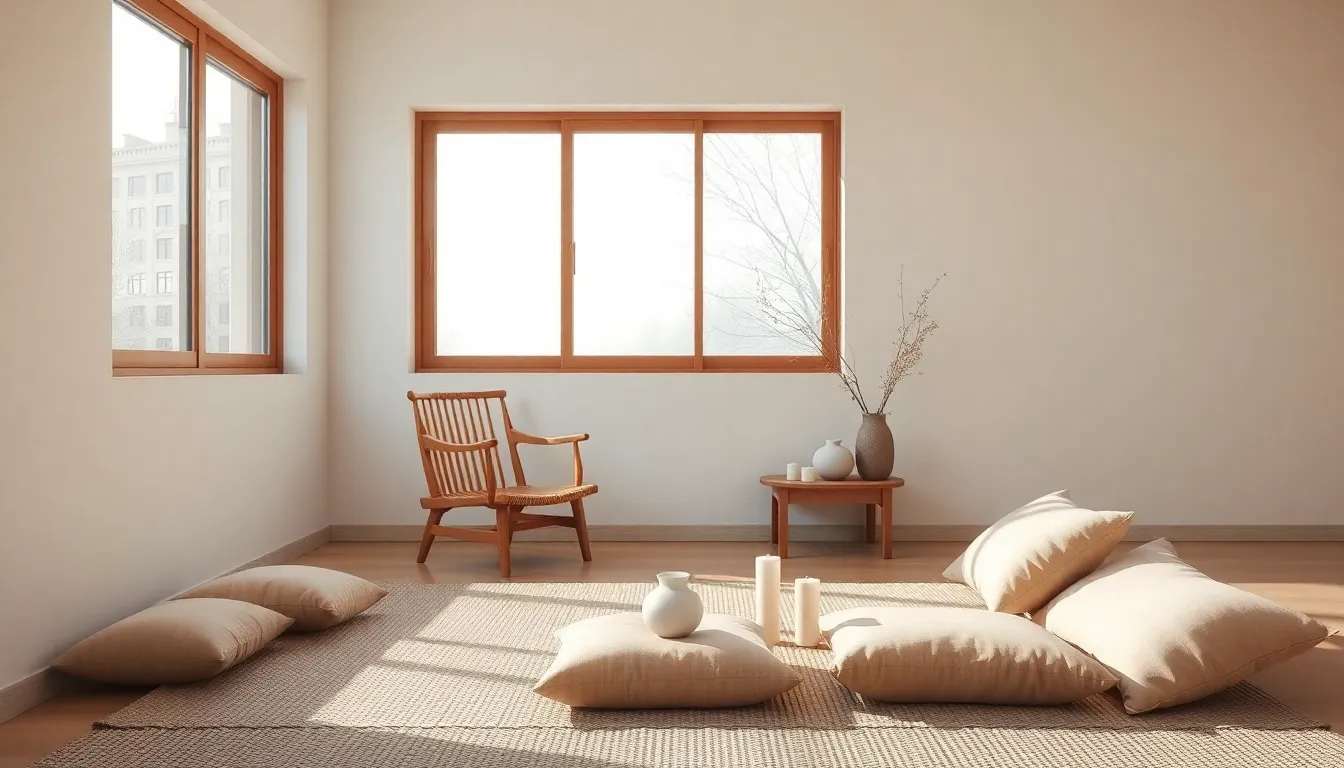
Creating exact areas for mindfulness and relaxation transforms your Japandi living room into a sanctuary for mental wellness. These thoughtfully designed zones blend seamlessly with the minimalist aesthetic while providing peaceful retreats for daily practice.
Create a Quiet Corner for Mindfulness
Establish a dedicated mindfulness area by selecting the most peaceful corner of your living room, away from high-traffic areas and distractions. Position a minimalist chair or floor cushion facing a window to maximize natural light while maintaining your connection to the outdoors. We recommend choosing furniture with clean lines that complement your existing Japandi pieces, such as a simple wooden meditation stool or low-profile armchair in neutral tones.
Enhance the space with a small side table crafted from natural wood to hold essential items like meditation books, journals, or a simple water glass. Keep this area completely free from electronic devices and visual clutter to preserve the tranquil atmosphere essential for mindfulness practice. Add a single meaningful object, such as a handcrafted ceramic bowl or smooth river stone, to serve as a focal point during meditation sessions.
Add Floor Cushions for Comfortable Seating
Incorporate floor cushions made from natural materials like linen or cotton to create comfortable, informal seating that aligns with traditional Japanese customs. Choose cushions in neutral colors like warm beige, soft gray, or muted cream to maintain your established color palette while providing versatile seating options for meditation and relaxation.
Stack multiple cushions of varying sizes to accommodate different sitting positions and comfort preferences during extended meditation sessions. We suggest selecting cushions with removable covers for easy maintenance and longevity, ensuring they continue to enhance your serene environment over time. Place these cushions on a natural fiber rug or directly on hardwood floors to create a grounding connection with the earth’s elements.
Layer different textures by combining smooth cotton cushions with slightly nubby linen ones, adding subtle visual interest without disrupting the minimalist aesthetic. Position the cushions near your quiet corner to create a cohesive meditation zone that flows naturally with the rest of your Japandi living room design.
Include Subtle Aromatherapy Elements
Introduce gentle fragrances through essential oils and scented candles that promote relaxation without overwhelming the senses. Select calming scents like lavender, sandalwood, or eucalyptus that complement the natural materials in your space while improving the meditative atmosphere.
Use a simple ceramic or wooden essential oil diffuser that matches your neutral color scheme, placing it strategically within your meditation zone for optimal scent distribution. We recommend choosing diffusers with clean, geometric designs that reflect the minimalist principles of Japandi style while serving their functional purpose effectively.
Light natural soy or beeswax candles in simple glass holders or ceramic vessels during meditation sessions to create a multi-sensory experience that deepens relaxation. Keep aromatherapy elements subtle and understated, using only one scent at a time to avoid sensory overload and maintain the peaceful simplicity that defines authentic Japandi design.
Store essential oils and candles in a dedicated drawer or cabinet to keep surfaces clear and organized, bringing them out only when needed for meditation or relaxation practices.
Conclusion
Creating a Japandi living room isn’t just about following design trends—it’s about embracing a lifestyle that prioritizes peace and intentional living. We’ve shown you how this beautiful fusion of Japanese minimalism and Scandinavian hygge can transform your space into a sanctuary that nurtures both body and mind.
The journey to achieving authentic Japandi style requires patience and thoughtful curation. Every element we’ve discussed works together to create a harmonious whole that reflects your commitment to simplicity and quality.
Remember that your Japandi living room should evolve naturally over time. Start with the fundamentals we’ve outlined and gradually add elements that resonate with your personal vision of tranquil living. The result will be a space that truly feels like home—calm uncluttered and deeply connected to nature’s timeless beauty.
Frequently Asked Questions
What is Japandi design style?
Japandi is a design style that blends Japanese simplicity with Scandinavian coziness to create serene and inviting living spaces. It emphasizes clean lines, natural textures, neutral color palettes, and functionality while promoting calmness and minimalism in home interiors.
What materials are best for Japandi living rooms?
Natural materials are essential for authentic Japandi style. Focus on solid wood furniture like oak coffee tables and walnut side tables, bamboo and rattan accents such as woven pendant lights, and stone or ceramic elements like granite side tables and handmade pottery.
What colors work best in Japandi design?
Japandi design uses warm whites and soft beiges as primary wall colors, complemented by muted earth tones like earthy browns and soft grays. This color palette maintains an airy feel while adding depth and balance through harmonious cool and warm undertones.
How do I choose furniture for a Japandi living room?
Select furniture with clean lines and minimalist designs that emphasize simplicity and functionality. Choose low-profile seating options, geometric shapes like rectangles and gentle curves, and multi-functional storage solutions to maintain a clutter-free, harmonious space.
What Japanese elements can I incorporate into Japandi design?
Add authentic Japanese elements like Shoji screen room dividers for subtle separation, minimalist pottery and ceramics in neutral colors, traditional floor cushions for flexible seating, and tatami mats to enhance the serene atmosphere while maintaining minimalism.
How do I add Scandinavian hygge comfort to Japandi style?
Layer soft textiles like natural linen throws and cotton blankets in neutral shades. Add cashmere throws, organic cotton cushions, and sheepskin rugs for tactile warmth. Create cozy reading nooks with warm lighting using natural material lamps and paper lantern pendants.
How can I maximize natural light in Japandi spaces?
Remove heavy window treatments and use sheer curtains or bamboo blinds to filter sunlight while maintaining privacy. Place mirrors strategically, such as round mirrors with wooden frames or floor-leaning mirrors in light oak or bamboo, to reflect and amplify natural light.
What plants work best in Japandi living rooms?
Choose low-maintenance indoor plants like succulents, air plants, ferns, peace lilies, snake plants, and ZZ plants. Display them in simple ceramic planters with clean lines and matte finishes that complement the neutral color palette and minimalist aesthetic.
How do I maintain the minimalist look in Japandi design?
Focus on quality over quantity by investing in fewer, high-quality furniture pieces. Limit decorative items to three per surface, keep surfaces clear of unnecessary items, and use storage solutions with hidden compartments. Practice daily maintenance to reinforce organization.
Can I create a meditation space in my Japandi living room?
Yes, establish a quiet corner using minimalist furniture and natural materials. Add floor cushions made from linen or cotton for comfortable seating, and incorporate subtle aromatherapy elements like essential oils and candles to promote relaxation and mindfulness.







